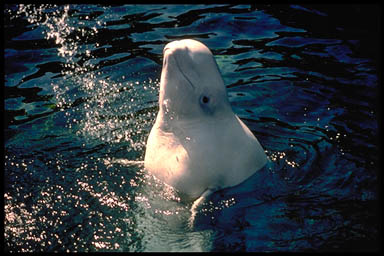Many Odd Characteristics of The
Beluga
Belugas
seem to be adapting at all times. They adapted to aquatic
existence around 50 million years ago. Fossils were recently
found in Mexico and California areas which means that they
have recently changed to prefer Arctic waters.
Look Ma! No
Dorsal Fin!
First of all, the genus name implies an adaptation within
itself. The genus literally means
"dolphin without a wing"
which leads to the fact that Belugas are lacking a dorsal
fin. The lack of the dorsal fin is predominant in all of the
3 arctic whales and arctic dolphin. Instead of the dorsal
fin they have a rough ridge along their back that many
researchers believe has shrunken down throughout the years
and now may only be used to break through ice in their
pathways. Other theories exist about the missing fin are
that it possibly was lost because it lost too much heat
through the large surface area of the fin or the other main
idea is that it was vulnerable to damage from swimming
through the ice blocks. The dorsal fin is not the only fins
that have changed. The Beluga's pectoral fins (side fins)
are much smaller and differently shaped from other whales.
The fins become shaped like a "J" as the whale ages.
.jpg)
***NOTE: The yellow color
of the above represents the Beluga skin which is ready
to
Molt.
(Belugas molt every summer; their skin turns yellow and
when it does they rub their body on rocks and sand to
lose their older skin.)
Look At
the Size of That Melon!
Another adaptation is the Beluga's giant melon! The head of
the Beluga is called the melon because of the large,
oil-filled, forehead. Normally, the melon is considered a
part of the Beluga's unique ability to use echolocation.
Echolocation is
the ability to send out clicks and sounds using the sacs
around the blowhole. Then the sounds bounce off an object
and then received back at the forehead of the whale. Belugas
are extremely vocal whales and have rightfully been given
the nickname Sea Canaries. This
ability is specific to toothed- whales and dolphins. The
other less significant use of the melon is to show
facial expression. The whale
can change the amount of oil in the forehead therefore
making different faces.
No Pain in the Neck!
Probably one of the more important
adaptations of the Beluga is that unlike other cetaceans,
belugas cervical vertebrate is
not fused.
Therefore, the Beluga can move it's head in all directions,
most whales can not turn its head to the sides but this
allows the Beluga to be able to. Two very small free bones
serve as the sites for muscle attachment, so when the whale
turns it's head the constriction of the neck is easily seen.
** Beluga is "spyhopping".
The action of popping head out of water to look
around.**

(Top Picture) Permission by:
Pallas, P.S., 1776.
Reise durch verschiedene Provinzen des Russischen Reichs,
(Bottom picture) Permission by: NOAA.
(online).
|